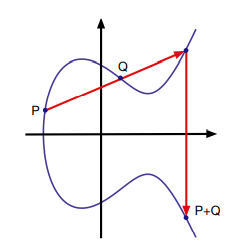Is really rational number in
an elliptic curve? This is the big question about complicated geometry, and it is very hard to capture it. We use prime numbers as modulo to avoid it. I think that it is
fractal.
You see the circle.
x^2+y^2=1
a/c and b/c are rational.
(a/c)^2+(b/c)^2=1
x=a/c, y=b/c
∴
a=cx, b=cy
(1/2)ab=1
This is half of rectangular ab.
a^2+b^2=c^2
(3,4,5) is Congruent number which is rational, but 1 is not.
if ab=2, a=1 and b=2. c is irrational.
This is contradictory.
(1/2)cx*cy=(1/2)c^2*xy=1
You see
the rational point P.
You put P on x and y.
Then you get an elliptic curve.
Y^2=X^3-X
You use modulo.
For example, you see modulo 3.
You get x=(0,1,2) because 3 is 0 in modulo. You put it in y^2. y^2=(0,1,4)=(0,1,1) in modulo. Then, x^3-x=(0,0,6)=(0,0,0) in modulo.
You compare y^2 and x^3-x in modulo. You get (0,1,1) and (0,0,0). You see 0 in both side. x=(0,1,2) and y=(0,0,0)
You have 3 in y. This is prime number.
You repeat it over and over again. The sum of y is sometime prime, but you always have prime as modulo. 0 is hopeless but it is only solution according to Fermat.




























